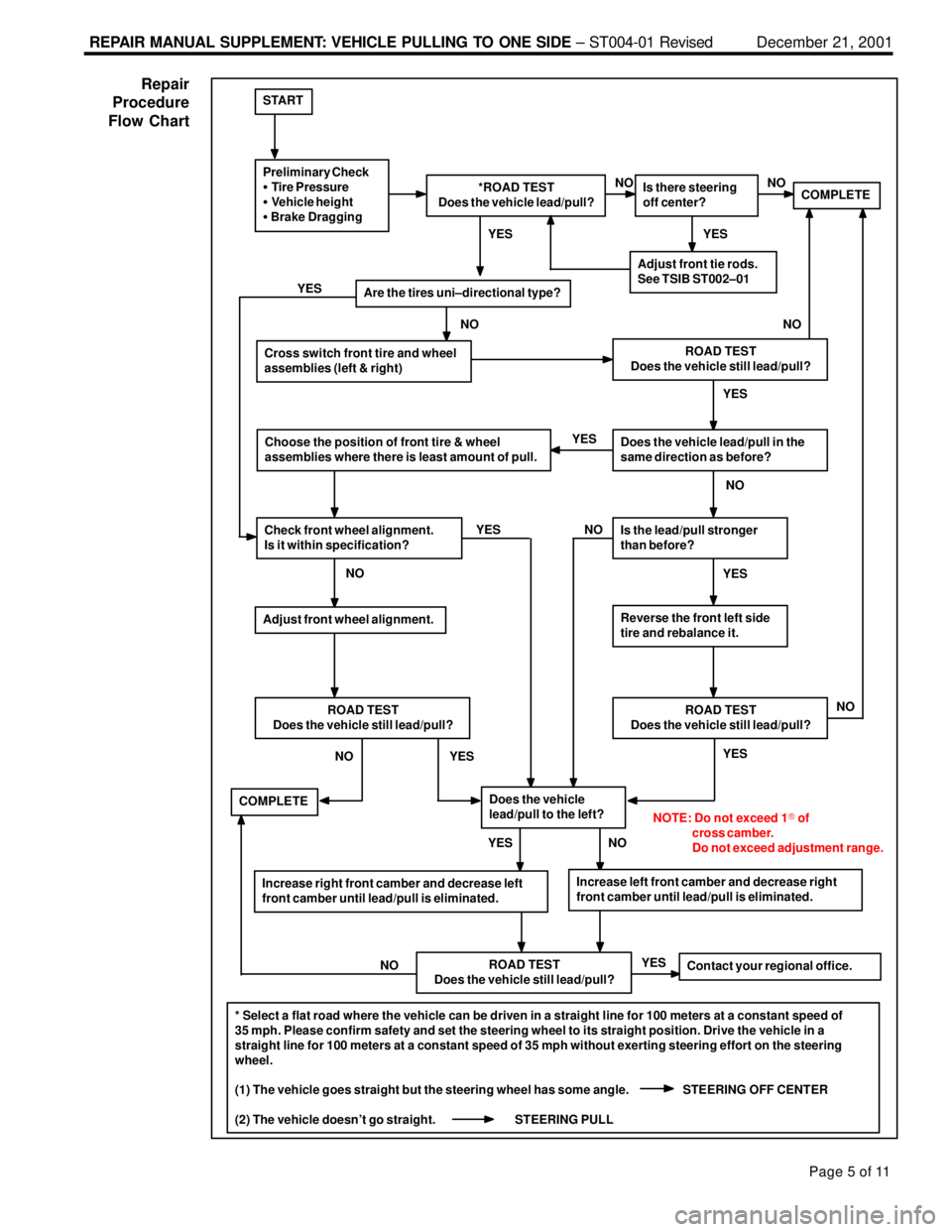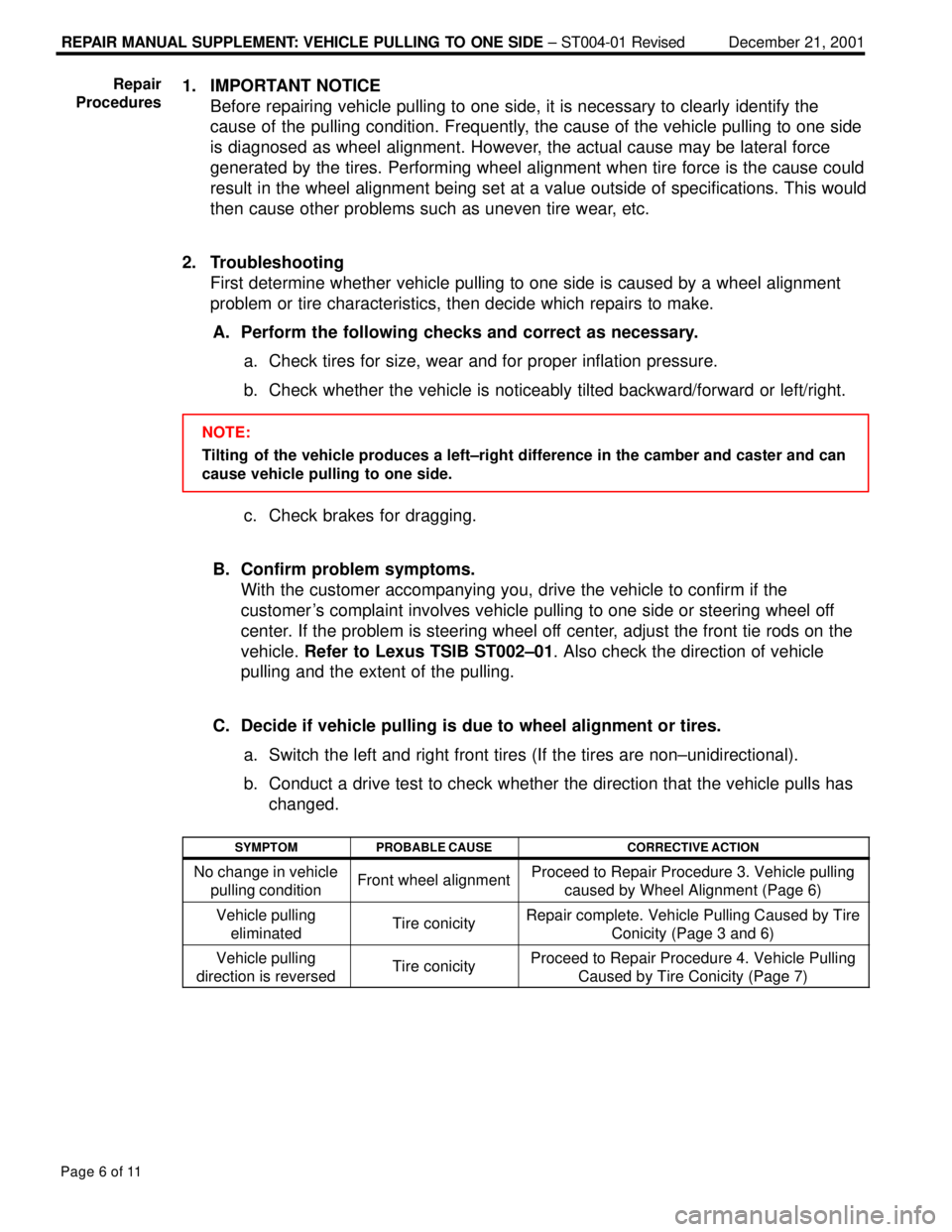Page 952 of 969

REPAIR MANUAL SUPPLEMENT: VEHICLE PULLING TO ONE SIDE ± ST004-01 RevisedDecember 21, 2001
Page 5 of 11
* Select a flat road where the vehicle can be driven in a straight line for 100 meters at a constant speed of
35 mph. Please confirm safety and set the steering wheel to its straight position. Drive the vehicle in a
straight line for 100 meters at a constant speed of 35 mph without exerting steering effort on the steering
wheel.
(1) The vehicle goes straight but the steering wheel has some angle. STEERING OFF CENTER
(2) The vehicle doesn't go straight. STEERING PULLYES
START
Preliminary Check
� Tire Pressure
� Vehicle height
� Brake Dragging*ROAD TEST
Does the vehicle lead/pull?Is there steering
off center?COMPLETE
Adjust front tie rods.
See TSIB ST002±01
Are the tires uni±directional type?
Cross switch front tire and wheel
assemblies (left & right)ROAD TEST
Does the vehicle still lead/pull?
Does the vehicle lead/pull in the
same direction as before?
Is the lead/pull stronger
than before?
Reverse the front left side
tire and rebalance it.
ROAD TEST
Does the vehicle still lead/pull?
Increase left front camber and decrease right
front camber until lead/pull is eliminated.
Does the vehicle
lead/pull to the left?
ROAD TEST
Does the vehicle still lead/pull?
Increase right front camber and decrease left
front camber until lead/pull is eliminated.
Contact your regional office.
COMPLETE
Choose the position of front tire & wheel
assemblies where there is least amount of pull.
Check front wheel alignment.
Is it within specification?
ROAD TEST
Does the vehicle still lead/pull?
Adjust front wheel alignment.
NOTE: Do not exceed 1� of
cross camber.
Do not exceed adjustment range.
NO YES YES
YES
YES
YESNO
NO YES
NO NO YESNO YESYES YES
NONO NO
NO NO
Repair
Procedure
Flow Chart
Page 953 of 969

REPAIR MANUAL SUPPLEMENT: VEHICLE PULLING TO ONE SIDE ± ST004-01 RevisedDecember 21, 2001
Page 6 of 11
1. IMPORTANT NOTICE
Before repairing vehicle pulling to one side, it is necessary to clearly identify the
cause of the pulling condition. Frequently, the cause of the vehicle pulling to one side
is diagnosed as wheel alignment. However, the actual cause may be lateral force
generated by the tires. Performing wheel alignment when tire force is the cause could
result in the wheel alignment being set at a value outside of specifications. This would
then cause other problems such as uneven tire wear, etc.
2. Troubleshooting
First determine whether vehicle pulling to one side is caused by a wheel alignment
problem or tire characteristics, then decide which repairs to make.
A. Perform the following checks and correct as necessary.
a. Check tires for size, wear and for proper inflation pressure.
b. Check whether the vehicle is noticeably tilted backward/forward or left/right.
NOTE:
Tilting of the vehicle produces a left±right difference in the camber and caster and can
cause vehicle pulling to one side.
c. Check brakes for dragging.
B. Confirm problem symptoms.
With the customer accompanying you, drive the vehicle to confirm if the
customer 's complaint involves vehicle pulling to one side or steering wheel off
center. If the problem is steering wheel off center, adjust the front tie rods on the
vehicle. Refer to Lexus TSIB ST002±01. Also check the direction of vehicle
pulling and the extent of the pulling.
C. Decide if vehicle pulling is due to wheel alignment or tires.
a. Switch the left and right front tires (If the tires are non±unidirectional).
b. Conduct a drive test to check whether the direction that the vehicle pulls has
changed.
SYMPTOMPROBABLE CAUSECORRECTIVE ACTION
No change in vehicle
pulling conditionFront wheel alignmentProceed to Repair Procedure 3. Vehicle pulling
caused by Wheel Alignment (Page 6)
Vehicle pulling
eliminatedTire conicityRepair complete. Vehicle Pulling Caused by Tire
Conicity (Page 3 and 6)
Vehicle pulling
direction is reversedTire conicityProceed to Repair Procedure 4. Vehicle Pulling
Caused by Tire Conicity (Page 7)
Repair
Procedures
Page 968 of 969
28009-17
R03031
F13676
Front (A) (B)
C80976
- TIRE & WHEELWHEEL AND TIRE SYSTEM
28-1
2402 Author�: Date�:
2005 LEXUS ES330 REPAIR MANUAL (RM1124U)
WHEEL AND TIRE SYSTEM
INSPECTION
1. INSPECT TIRE
(a) Check the tires for wear and proper inflation pressure.
Cold tire inflation pressure:
Tire sizeFront, Rear
kPa (kgf/cm2, psi)
P215/60R16 94V200 (2.0, 29)
P215/55R17 93V210 (2.1, 30)
(b) Using a dial indicator, check the tire runout.
Tire runout: 1.0 mm (0.039 in.) or less
2. ROTATE TIRES
HINT:
�Rotate tires as shown in illustration (A) if a spare tire is not
included in the rotation.
�Rotate tires as shown in illuatration (B) if a spare tire is in-
cluded in the rotation.
3. INSPECT WHEEL BALANCE
(a) Check and adjust the Off-the-car balance.
(b) If necessary, check and adjust the On-the-car balance.
Imbalance after adjustment: 8.0 g (0.018 lb) or less
4. INSPECT BEARING LOOSENESS (SEE PAGE 30-2)
5. INSPECT AXLE HUB RUNOUT (SEE PAGE 30-2)